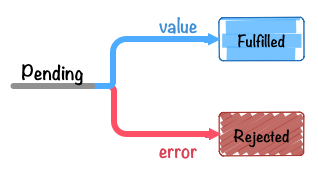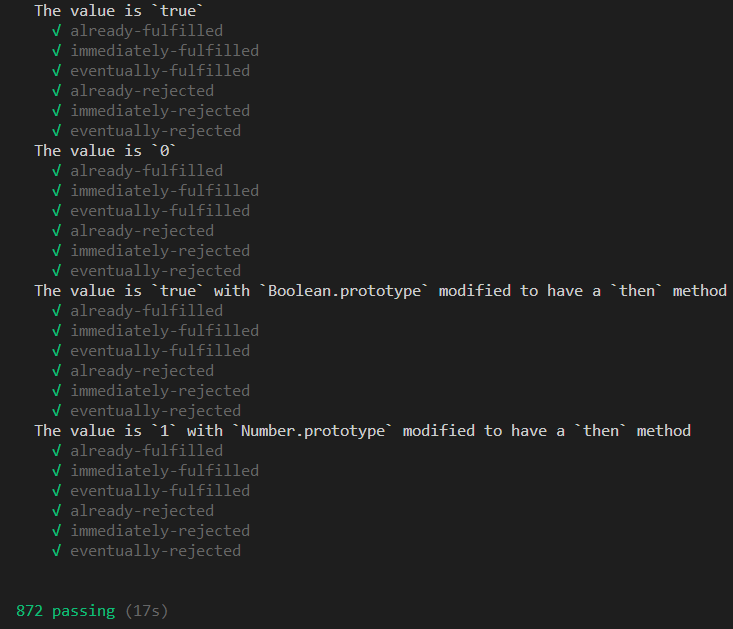面试的时候经常会问到Promise的使用;有的面试官再深入一点,会继续问是否了解Promise的实现方式,或者有没有阅读过Promise的源码;今天我们就来看一下,Promise在内部是如何实现来链式调用的。
什么是Promise 所谓Promise,简单说就是一个容器,里面保存着某个未来才会结束的事件(通常是一个异步操作)的结果。从语法上说,Promise 是一个对象,从它可以获取异步操作的消息。Promise提供统一的API,各种异步操作都可以用同样的方法进行处理。
Promise出现之前都是通过回调函数来实现,回调函数本身没有问题,但是嵌套层级过深,很容易掉进回调地狱。
const fs = require ('fs' );readFile ('1.txt' , (err,data ) => {readFile ('2.txt' , (err,data ) => {readFile ('3.txt' , (err,data ) => {
如果每次读取文件后还要进行逻辑的判断或者异常的处理,那么整个回调函数就会非常复杂且难以维护。Promise的出现正是为了解决这个痛点,我们可以把上面的回调嵌套用Promise改写一下:
1 2 3 4 5 6 7 8 9 10 11 12 13 14 15 16 17 18 19 20 const readFile = function (fileName ){return new Promise ((resolve, reject )=> {readFile (fileName, (err, data )=> {if (err){reject (err)else {resolve (data)readFile ('1.txt' )then (data =>return readFile ('2.txt' );then (data =>return readFile ('3.txt' );then (data =>
Promise规范 promise最早是在commonjs社区提出来的,当时提出了很多规范。比较接受的是promise/A规范。但是promise/A规范比较简单,后来人们在这个基础上,提出了promise/A+规范,也就是实际上的业内推行的规范;es6也是采用的这种规范,但是es6在此规范上还加入了Promise.all、Promise.race、Promise.catch、Promise.resolve、Promise.reject等方法。
谢小飞博客专用防爬虫链接,想要看最新的前端博客请点这里
我们可以通过脚本来测试我们写的Promise是否符合promise/A+的规范。将我们实现的Promise加入以下代码:
Promise .defer = Promise .deferred = function (let dfd = {};promise = new Promise ((resolve, reject ) => {resolve = resolve;reject = reject;return dfd;
然后通过module.exports导出,安装测试的脚本:
npm install -g promises-aplus-tests
谢小飞博客专用防爬虫链接,想要看最新的前端博客请点这里
在实现Promise的目录执行以下命令:
promises-aplus-tests promise.js
接下来,脚本会对照着promise/A+的规范,对我们的脚本来一条一条地进行测试。
Promise基本结构 我们先回顾一下,我们平时都是怎么使用Promise的:
谢小飞博客专用防爬虫链接,想要看最新的前端博客请点这里
var p = new Promise (function (resolve, reject ){console .log ('执行' )setTimeout (function (resolve (2 )1000 )then (function (res ){console .log ('suc' ,res)function (err ){console .log ('err' ,err)
首先看出来,Promise是通过构造函数实例化一个对象,然后通过实例对象上的then方法,来处理异步返回的结果。同时,promise/A+规范规定了:
promise 是一个拥有 then 方法的对象或函数,其行为符合本规范;
一个 Promise 的当前状态必须为以下三种状态中的一种:等待态(Pending)、执行态(Fulfilled)和拒绝态(Rejected)。
1 2 3 4 5 6 7 8 9 10 11 12 13 14 15 16 17 const PENDING = 'pending' const FULFILLED = 'fulfilled' const REJECTED = 'rejected' function Promise (executor ) {var _this = this this .state = PENDING ; this .value = undefined ; this .reason = undefined ; function resolve (value ) {}function reject (reason ) {}Promise .prototype then = function (onFulfilled, onRejected ) {module .exports = Promise ;
当我们实例化Promise时,构造函数会马上调用传入的执行函数executor,我们可以试一下:
let p = new Promise ((resolve, reject ) => {console .log ('执行了' );
因此在Promise中构造函数立马执行,同时将resolve函数和reject函数作为参数传入:
谢小飞博客专用防爬虫链接,想要看最新的前端博客请点这里
function Promise (executor ) {var _this = this this .state = PENDING ; this .value = undefined ; this .reason = undefined ; function resolve (value ) {}function reject (reason ) {}executor (resolve, reject)
但是executor也会可能存在异常,因此通过try/catch来捕获一下异常情况:
try {executor (resolve, reject);catch (e) {reject (e);
不可变 promise/A+规范中规定,当Promise对象已经由等待态(Pending)改变为执行态(Fulfilled)或者拒绝态(Rejected)后,就不能再次更改状态,且终值也不可改变。
因此我们在回调函数resolve和reject中判断,只能是pending状态的时候才能更改状态:
function resolve (value ) {if (_this.state === PENDING ){state = FULFILLED value = valuefunction reject (reason ) {if (_this.state === PENDING ){state = REJECTED reason = reason
我们更改状态的同时,将回调函数中成功的结果或者失败的原因都保存在对应的属性中,方便以后来获取。
谢小飞博客专用防爬虫链接,想要看最新的前端博客请点这里
then实现 当Promise的状态改变之后,不管成功还是失败,都会触发then回调函数。因此,then的实现也很简单,就是根据状态的不同,来调用不同处理终值的函数。
Promise .prototype then = function (onFulfilled, onRejected ) {if (this .state === FULFILLED ){typeof onFulfilled === 'function' && onFulfilled (this .value )if (this .state === REJECTED ){typeof onRejected === 'function' && onRejected (this .reason )
在规范中也说了,onFulfilled和onRejected是可选的,因此我们对两个值进行一下类型的判断:
onFulfilled 和 onRejected 都是可选参数。如果 onFulfilled 不是函数,其必须被忽略。如果 onRejected 不是函数,其必须被忽略
代码写到这里,貌似该有的实现方式都有了,我们来写个demo测试一下:
var myP = new Promise (function (resolve, reject ){console .log ('执行' )setTimeout (function (reject (3 )1000 )then (function (res ){console .log (res)function (err ){console .log (err)
然鹅,很遗憾,运行起来我们发现只打印了构造函数中的执行,下面的then函数根本都没有执行。我们整理一下代码的运行流畅:
谢小飞博客专用防爬虫链接,想要看最新的前端博客请点这里
当then里面函数运行时,resolve由于是异步执行的,还没有来得及修改state,此时还是PENDING状态;因此我们需要对异步的情况做一下处理。
支持异步 那么如何让我们的Promise来支持异步呢?我们可以参考发布订阅模式,在执行then方法的时候,如果当前还是PENDING状态,就把回调函数寄存到一个数组中,当状态发生改变时,去数组中取出回调函数;因此我们先在Promise中定义一下变量:
function Promise (executor ) {this .onFulfilled = [];this .onRejected = [];
这样,当then执行时,如果还是PENDING状态,我们不是马上去执行回调函数,而是将其存储起来:
Promise .prototype then = function (onFulfilled, onRejected ) {if (this .state === FULFILLED ){typeof onFulfilled === 'function' && onFulfilled (this .value )if (this .state === REJECTED ){typeof onRejected === 'function' && onRejected (this .reason )if (this .state === PENDING ){typeof onFulfilled === 'function' && this .onFulfilled .push (onFulfilled)typeof onRejected === 'function' && this .onRejected .push (onRejected)
存储起来后,当resolve或者reject异步执行的时候就可以来调用了:
function resolve (value ) {if (_this.state === PENDING ){state = FULFILLED value = valueonFulfilled .forEach (fn =>fn (value))function reject (reason ) {if (_this.state === PENDING ){state = REJECTED reason = reasononRejected .forEach (fn =>fn (reason))
有童鞋可能会提出疑问了,为什么这边onFulfilled和onRejected要存在数组中,直接用一个变量接收不是也可以么?下面看一个例子:
var p = new Promise ((resolve, reject )=> {setTimeout (()=> {resolve (4 )0 )then ((res )=> {console .log (res, 'res' )then ((res1 )=> {console .log (res1, 'res1' )
我们分别调用了两次then,如果是一个变量的话,最后肯定只会运行后一个then,把之前的覆盖了,如果是数组的话,两个then都能正常运行。
谢小飞博客专用防爬虫链接,想要看最新的前端博客请点这里
至此,我们运行demo,就能如愿以偿的看到运行结果了;一个四十行左右的简单Promise垫片就此完成了。这里贴一下完整的代码:
1 2 3 4 5 6 7 8 9 10 11 12 13 14 15 16 17 18 19 20 21 22 23 24 25 26 27 28 29 30 31 32 33 34 35 36 37 38 39 40 41 42 43 const PENDING = 'pending' const FULFILLED = 'fulfilled' const REJECTED = 'rejected' function Promise (executor ) {var _this = this this .state = PENDING ; this .value = undefined ; this .reason = undefined ; this .onFulfilled = [];this .onRejected = []; function resolve (value ) {if (_this.state === PENDING ){state = FULFILLED value = valueonFulfilled .forEach (fn =>fn (value))function reject (reason ) {if (_this.state === PENDING ){state = REJECTED reason = reasononRejected .forEach (fn =>fn (reason))try {executor (resolve, reject);catch (e) {reject (e);Promise .prototype then = function (onFulfilled, onRejected ) {if (this .state === FULFILLED ){typeof onFulfilled === 'function' && onFulfilled (this .value )if (this .state === REJECTED ){typeof onRejected === 'function' && onRejected (this .reason )if (this .state === PENDING ){typeof onFulfilled === 'function' && this .onFulfilled .push (onFulfilled)typeof onRejected === 'function' && this .onRejected .push (onRejected)
链式调用then 相信上面的Promise垫片应该很容易理解,下面链式调用才是Promise的难点和核心点;我们对照promise/A+规范,一步一步地来实现,我们先来看一下规范是如何来定义的:
then 方法必须返回一个 promise 对象
谢小飞博客专用防爬虫链接,想要看最新的前端博客请点这里
promise2 = promise1.then(onFulfilled, onRejected);
也就是说,每个then方法都要返回一个新的Promise对象,这样我们的then方法才能不断的链式调用;因此上面的简单垫片中then方法就不适用了,因为它什么都没有返回,我们对其进行简单的改写,不论then进行什么操作,都返回一个新的Promise对象:
Promise .prototype then = function (onFulfilled, onRejected ) {let promise2 = new Promise ((resolve, reject )=> {return promise2
我们继续看then的执行过程:
如果 onFulfilled 或者 onRejected 返回一个值 x ,则运行下面的 Promise 解决过程:[[Resolve]](promise2, x)
如果 onFulfilled 或者 onRejected 抛出一个异常 e ,则 promise2 必须拒绝执行,并返回拒因 e
如果 onFulfilled 不是函数且 promise1 成功执行, promise2 必须成功执行并返回相同的值
谢小飞博客专用防爬虫链接,想要看最新的前端博客请点这里
如果 onRejected 不是函数且 promise1 拒绝执行, promise2 必须拒绝执行并返回相同的据因
首先第一点,我们知道onFulfilled和onRejected执行之后都会有一个返回值x,对返回值x处理就需要用到Promise解决过程,这个我们下面再说;第二点需要对onFulfilled和onRejected进行异常处理,没什么好说的;第三和第四点,说的其实是一个问题,如果onFulfilled和onRejected两个参数没有传,则继续往下传(值的传递特性);举个例子:
var p = new Promise (function (resolve, reject ){setTimeout (function (resolve (3 )1000 )then (1 ,1 )then ('' ,'' )then ()then (function (res ){console .log (res)
这里不管onFulfilled和onRejected传什么值,只要不是函数,就继续向下传入,直到有函数进行接收;因此我们对then方法进行如下完善:
1 2 3 4 5 6 7 8 9 10 11 12 13 14 15 16 17 18 19 20 21 22 23 var _this = this typeof onFulfilled === 'function' ? onFulfilled : value =>typeof onRejected === 'function' ? onRejected : reason =>throw reason }var promise2 = new Promise ((resolve, reject )=> {if (_this.state === FULFILLED ){let x = onFulfilled (_this.value )resolvePromise (promise2, x, resolve, reject)else if (_this.state === REJECTED ){let x = onRejected (_this.reason )resolvePromise (promise2, x ,resolve, reject)else if (_this.state === PENDING ){onFulfilled .push (()=> {let x = onFulfilled (_this.value )resolvePromise (promise2, x, resolve, reject)onRejected .push (()=> {let x = onRejected (_this.reason )resolvePromise (promise2, x ,resolve, reject)
我们发现函数中有一个resolvePromise,就是上面说的Promise解决过程,它是对新的promise2和上一个执行结果 x 的处理,由于具有复用性,我们把它抽成一个单独的函数,这也是上面规范中定义的第一点。
由于then的回调是异步执行的,因此我们需要把onFulfilled和onRejected执行放到异步中去执行,同时做一下错误的处理:
1 2 3 4 5 6 7 8 9 10 11 12 13 14 15 16 17 18 19 20 21 22 23 24 25 26 27 28 29 30 31 32 33 34 35 36 37 38 39 40 41 if (_this.state === FULFILLED ){setTimeout (()=> {try {let x = onFulfilled (_this.value )resolvePromise (promise2, x, resolve, reject)catch (error) {reject (error)else if (_this.state === REJECTED ){setTimeout (()=> {try { let x = onRejected (_this.reason )resolvePromise (promise2, x ,resolve, reject)catch (error) {reject (error)else if (_this.state === PENDING ){onFulfilled .push (()=> {setTimeout (()=> {try { let x = onFulfilled (_this.value )resolvePromise (promise2, x, resolve, reject)catch (error) {reject (error)onRejected .push (()=> {setTimeout (()=> {try { let x = onRejected (_this.reason )resolvePromise (promise2, x ,resolve, reject)catch (error) {reject (error)
Promise解决过程
Promise 解决过程是一个抽象的操作,其需输入一个 promise 和一个值,我们表示为 [[Resolve]](promise, x),如果 x 有 then 方法且看上去像一个 Promise ,解决程序即尝试使 promise 接受 x 的状态;否则其用 x 的值来执行 promise 。
谢小飞博客专用防爬虫链接,想要看最新的前端博客请点这里
这段话比较抽象,通俗一点的来说就是promise的解决过程需要传入一个新的promise和一个值x,如果传入的x是一个thenable的对象(具有then方法),就接受x的状态:
function resolvePromise (promise2, x, resolve, reject ) {
定义好函数后,来看具体的操作说明:
谢小飞博客专用防爬虫链接,想要看最新的前端博客请点这里
x 与 promise 相等
如果 promise 和 x 指向同一对象,以 TypeError 为据因拒绝执行 promise
x 为 Promise
如果 x 处于等待态, promise 需保持为等待态直至 x 被执行或拒绝
如果 x 处于执行态,用相同的值执行 promise
如果 x 处于拒绝态,用相同的据因拒绝 promise
x 为对象或函数
把 x.then 赋值给 then
谢小飞博客专用防爬虫链接,想要看最新的前端博客请点这里
如果取 x.then 的值时抛出错误 e ,则以 e 为据因拒绝 promise
如果 then 是函数,将 x 作为函数的作用域 this 调用之。传递两个回调函数作为参数,第一个参数叫做 resolvePromise ,第二个参数叫做 rejectPromise:
如果 resolvePromise 以值 y 为参数被调用,则运行 [[Resolve]](promise, y)
如果 rejectPromise 以据因 r 为参数被调用,则以据因 r 拒绝 promise
如果 resolvePromise 和 rejectPromise 均被调用,或者被同一参数调用了多次,则优先采用首次调用并忽略剩下的调用
如果 then 不是函数,以 x 为参数执行 promise
如果 x 不为对象或者函数,以 x 为参数执行 promise
首先第一点,如果x和promise相等,这是一种什么情况呢,就是相当于把自己返回出去了:
var p = new Promise (function (resolve, reject ){resolve (3 )var p2 = p.then (function (return p2
这样会陷入一个死循环中,因此我们首先要把这种情况给排除掉:
谢小飞博客专用防爬虫链接,想要看最新的前端博客请点这里
function resolvePromise (promise2, x, resolve, reject ) {if (promise2 === x) {reject (new TypeError ('Chaining cycle' ));
接下来就是对不同情况的判断了,首先我们把 x 为对象或者函数的情况给判断出来:
function resolvePromise (promise2, x, resolve, reject ) {if (promise2 === x) {reject (new TypeError ('Chaining cycle' ));if (x !== null && (typeof x === 'object' || typeof x === 'function' )) {else {resolve (x)
谢小飞博客专用防爬虫链接,想要看最新的前端博客请点这里
如果 x 为对象或函数,就把 x.then 赋值给 then好理解,但是第二点取then有可能会报错是为什么呢?这是因为需要考虑到所有出错的情况(防小人不防君子),如果有人实现Promise对象的时候使用Object.defineProperty()恶意抛错,导致程序崩溃,就像这样:
var Promise = {};Object .defineProperty (Promise , 'then' , {get : function (throw Error ('error' )Promise .then
因此,我们取then的时候也需要try/catch:
if (x !== null && (typeof x === 'object' || typeof x === 'function' )) {try {let then = x.then catch (e){reject (e)
取出then后,回到3.3,判断如果是一个函数,就将 x 作为函数的作用域 this 调用,同时传入两个回调函数作为参数。
try {let then = x.then if (typeof then === 'function' ){call (x, (y )=> {resolve (y)(r ) => {reject (r)else {resolve (x)catch (e){reject (e)
这样,我们的链式调用就能顺利的调用起来了;但是还有一种特殊的情况,如果resolve的y值还是一个Promise对象,这时就应该继续执行,比如下面的例子:
var p1 = new Promise ((resolve, reject )=> {resolve ('p1' )then ((res )=> {return new Promise ((resolve, reject )=> {resolve (new Promise ((resolve, reject )=> {resolve ('p2' )then ((res1 )=> {console .log (res1)
这时候第二个then打印出来的是一个promise对象;我们应该继续递归调用resolvePromise(参考规范3.3.1),因此,最终resolvePromise的完整代码如下:
谢小飞博客专用防爬虫链接,想要看最新的前端博客请点这里
1 2 3 4 5 6 7 8 9 10 11 12 13 14 15 16 17 18 19 20 21 22 23 24 25 26 27 28 29 30 31 32 function resolvePromise (promise2, x, resolve, reject ){if (promise2 === x){reject (new TypeError ('Chaining cycle' ))if (x && typeof x === 'object' || typeof x === 'function' ){let used;try {let then = x.then if (typeof then === 'function' ){call (x, (y )=> {if (used) return ;true resolvePromise (promise2, y, resolve, reject)(r ) => {if (used) return ;true reject (r)else {if (used) return ;true resolve (x)catch (e){if (used) return ;true reject (e)else {resolve (x)
到这里,我们的Promise也能够完整的实现链式调用了;然后把代码用promises-aplus-tests测试一下,完美的通过了872项测试。
1 2 3 4 5 6 7 8 9 10 11 12 13 14 15 16 17 18 19 20 21 22 23 24 25 26 27 28 29 30 31 32 33 34 35 36 37 38 39 40 41 42 43 44 45 46 47 48 49 50 51 52 53 54 55 56 57 58 59 60 61 62 63 64 65 66 67 68 69 70 71 72 73 74 75 76 77 78 79 80 81 82 83 84 85 86 87 88 89 90 91 92 93 94 95 96 97 98 99 100 101 102 103 104 105 106 107 108 109 110 111 112 113 114 115 116 117 118 119 120 121 122 123 124 125 126 127 128 129 130 131 132 const PENDING = 'pending' const FULFILLED = 'fulfilled' const REJECTED = 'rejected' function Promise (executor ) {var _this = this this .state = PENDING ; this .value = undefined ; this .reason = undefined ; this .onFulfilled = []this .onRejected = []function resolve (value ) {if (_this.state === PENDING ){state = FULFILLED value = valueonFulfilled .forEach (fn =>fn (value))function reject (reason ) {if (_this.state === PENDING ){state = REJECTED reason = reasononRejected .forEach (fn =>fn (reason))try {executor (resolve, reject)catch (error) {reject (error)Promise .prototype then = function (onFulfilled, onRejected ) {var _this = this typeof onFulfilled === 'function' ? onFulfilled : value =>typeof onRejected === 'function' ? onRejected : reason =>throw reason }var promise2 = new Promise ((resolve, reject )=> {if (_this.state === FULFILLED ){setTimeout (()=> {try {let x = onFulfilled (_this.value )resolvePromise (promise2, x, resolve, reject)catch (error) {reject (error)else if (_this.state === REJECTED ){setTimeout (()=> {try { let x = onRejected (_this.reason )resolvePromise (promise2, x ,resolve, reject)catch (error) {reject (error)else if (_this.state === PENDING ){onFulfilled .push (()=> {setTimeout (()=> {try { let x = onFulfilled (_this.value )resolvePromise (promise2, x, resolve, reject)catch (error) {reject (error)onRejected .push (()=> {setTimeout (()=> {try { let x = onRejected (_this.reason )resolvePromise (promise2, x ,resolve, reject)catch (error) {reject (error)return promise2function resolvePromise (promise2, x, resolve, reject ){if (promise2 === x){reject (new TypeError ('Chaining cycle' ))if (x && typeof x === 'object' || typeof x === 'function' ){let used;try {let then = x.then if (typeof then === 'function' ){call (x, (y )=> {if (used) return ;true resolvePromise (promise2, y, resolve, reject)(r ) => {if (used) return ;true reject (r)else {if (used) return ;true resolve (x)catch (e){if (used) return ;true reject (e)else {resolve (x)Promise .defer = Promise .deferred = function (let dfd = {};promise = new Promise ((resolve, reject ) => {resolve = resolve;reject = reject;return dfd;module .exports = Promise ;
参考 promise/A规范(英文) promise/A+规范(英文) promise/A+规范(中文)


